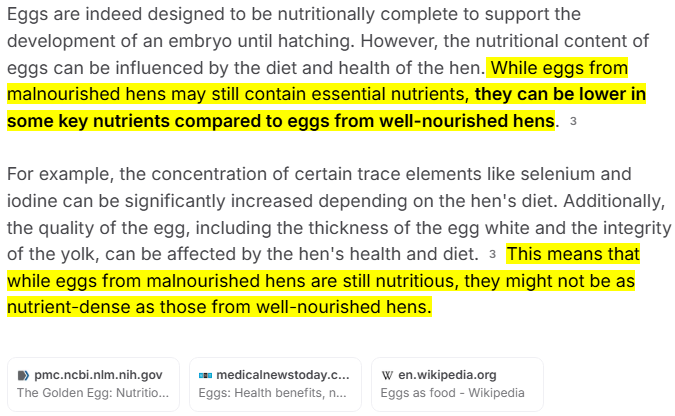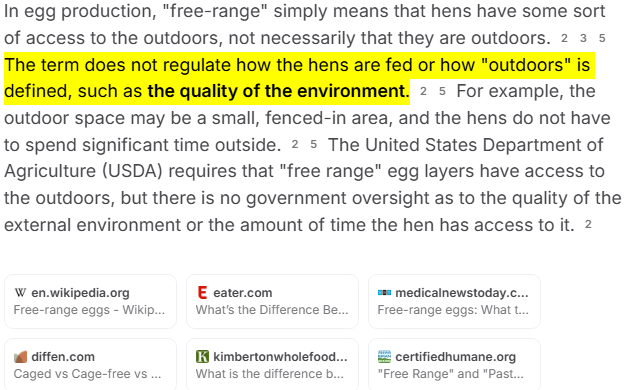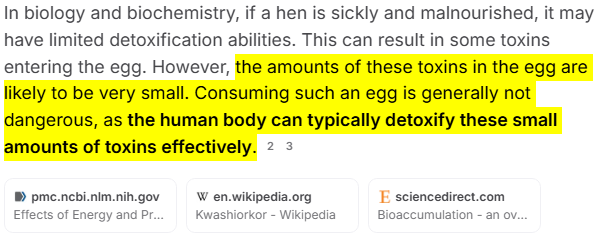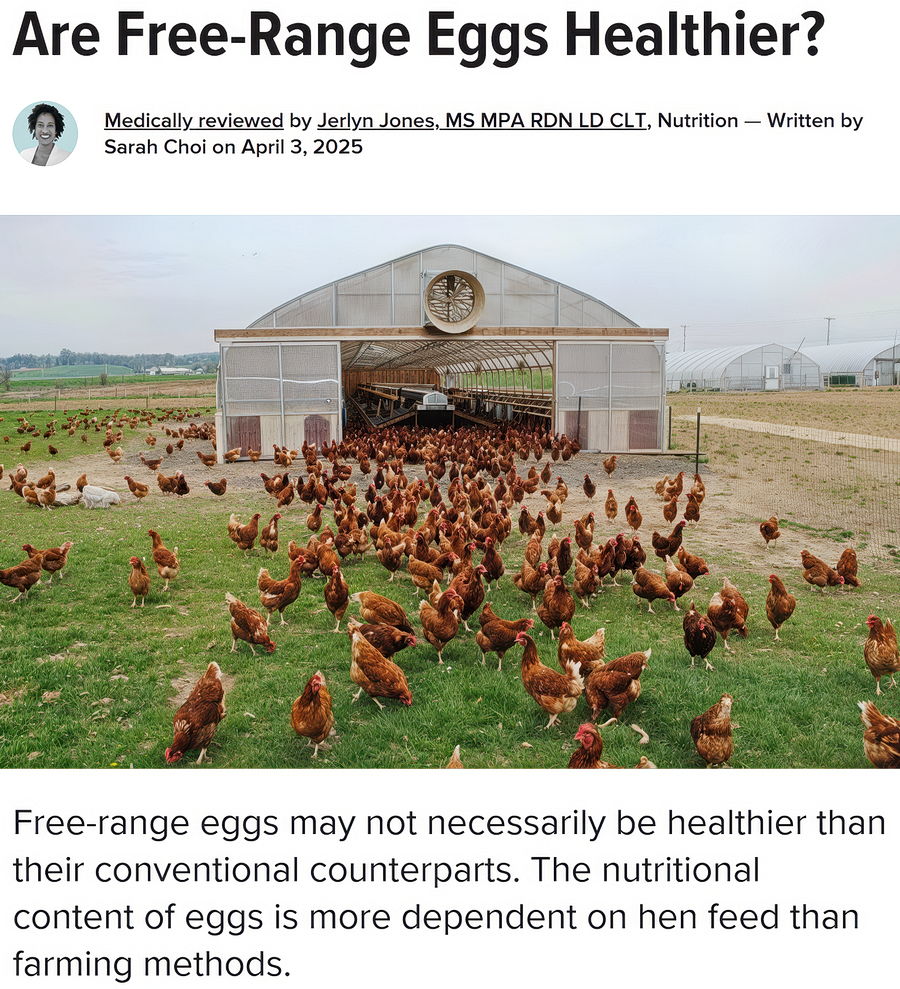Eggs are one of nature’s superfoods only surpassed by raw organ meats. And as the agenda-driven shills at Healthline recently posted an article about “free-range” eggs, I saw an opportunity to shed some light on all these somewhat misleading terms and whether it matters at all (from a nutrition perspective.) So, without further ado, let’s see what they had to say.
“Eggs are a nutritious staple food for many people. One large white egg has around 6 grams of protein and 70 calories. They also contain other important nutrients, such as B vitamins, selenium, and vitamin A.”
While eggs are not a “necessary” staple if you can get all the best cuts of fatty meat and organ meats you can imagine, they do pack one hell of a nutritious punch, and most people would greatly benefit from a lot of eggs in their diet. Of course, the shills at Healthline did not mention the most important fact about eggs, as in the essential life-giving cholesterol, the steroid lipid that our cells are built of, the crucial component of all cellular repair and healing, the key compound needed for the synthesis of bile acids and testosterone, the vital compound needed to absorb all the fat-soluble vitamins A, D, E, and K. Without cholesterol, you will wither away like a rotting vegan zombie and eventually die, as many “vegan influencers” have done as of lately.
And of course, as eggs are meant to be fertilized and turned into a life, it does contain all essential nutrients needed to grow and support a life. Hence, it is rich in all essential nutrients and therefore a complete and superior food. I covered eggs in depth in my articles “Article Review: Eggs, a Real Superfood” and “Real Superfood: Eggs to Prevent Alzheimer’s and Dementia.”
“But not all eggs are created equal. There are many types of eggs, and some may have more of these important nutrients than others.”
Yes. However, all eggs are nutritionally complete, even if the hens are malnourished. In that scenario, the eggs will simply be on the low side in certain nutrients that the hen might be lacking, but it will still be present as it is taken from the hens nutritional stores, from the hen’s body, as the egg, a new life, takes priority. That is simple biology and follows the universal law of survival of the species. The same way as when a mother is pregnant and carrying a child. If she does not consume enough animal-based foods, as humans are obligate hyper carnivores, she will become malnourished and her body will be broken down to supply nutrients for the growing fetus to the best of her abilities. Still, the child might be poorly developed and become sickly later in life, but it will still be born and “put together” as best as the circumstances allow.
I covered this in my articles “Starting or Expanding Your Family – How nutrition and toxins influence your child,” “A Mother’s Diet High In Plant-Based Carbohydrates And Seed Oils Will Destroy The Health, And Especially The Liver, Of A Growing Fetus,” “Maternal Toxicity Associated With Children’s Behavioral and Emotional Regulation,” “Prenatal Mental Health Issues? Focus On Nutrition Instead!,” “Changes To The Brain During Pregnancy Is Due To Nutrient Deficiencies,” and “Following A Vegan Diet Will Cause Severe Birth Defects And A Lower Birth Weight.”

Nutrition
“According to the American Egg Board, labels — including free-range — simply refer to the way the eggs were farmed. Unless the feed is fortified, the label does not necessarily indicate any significant nutritional differences.
Hens given nutritionally fortified feed produce eggs with higher nutrient levels. These eggs are labeled as nutrient or nutritionally enhanced, as opposed to labels like “cage-free” or “free-range,” and their packaging will specify nutrient content.”
The USDA term, “free-range” means that the eggs come from hens that have some sort of access to the outdoors. However, it doesn’t mean that the hens actually go outdoors, or that the outdoor space is more than a small, fenced-in area. It simply implies that a door exists that a farmer could at some point open.
Also, it does not regulate how the hens are fed, or what kind of environment this “outdoor” area provides — it could simply be a gravel yard and not a grass field full of insects and bugs.

When I grew up on our farm, we had a lot of hens at one point in time (the late 70’s and early 80’) before we up-scaled our sheep production (from about a hundred to 400 or more sheep.) The hens simply roamed in one of the smaller sheep pens close to the stables (about 100 x 200 meters which is 20000 square meters or 215278 square feet) with access to some of our barns where they could get shelter and lay eggs in the hay.
You see, in nature, hens that are free to roam typically eat a variety of foods, including grass seeds and all sorts of insects, bugs and small animals. They are omnivores and will peck at anything edible in their environment, which can include grains, fruits, cadavers, and small animals like worms or bugs.
The only definition in egg production that can come close to this natural environment is “pasture-raised.” With that said, pasture-raised is not a term regulated by the government or the USDA; however, if the carton says “pasture-raised” and also includes stamps that say “Certified Humane” and/or “Animal Welfare Approved,” it is certain that the hens have a good life. Certified Humane means that each hen was given 2 square feet a day for six hours while Animal Welfare Approved means that each hen was given 108 square feet of outdoor space, as well as barn space indoors. 108 square feet is the same as 10 square meters, which is for example an area of 2 x 5 meters (per hen, not total.)
This is pretty much as close to the natural farm vibe you’ll get when dealing with large-scale egg producers.

Apart from these definitions, you also have “cage-free,” which simply means that the eggs come from hens that aren’t caged. They can freely roam a “building,” a “room,” or an “enclosed area” with unlimited access to food and fresh water during their production cycle, but they do not have access to the outdoors. This means that the hens are fed whatever the producers seem beneficial and are within their budget, which is usually some sort of hen feed formula. These formulas are similar to anything that is fed to animals in captivity. It’s man-made kibble with a lot of added fake vitamins and chemicals which these backwards-thinking “nutritionists” believe is beneficial, when in fact, it only increases the toxic load in the poor animal. Still, the basis of the feed is usually corn, wheat, barley, seeds and other crap that the hens can metabolize some nutrition from, usually enough to keep them alive and producing eggs. Still, they do not get the really nutritious bugs and insects that are crucial for them to thrive and produce really nutritious eggs.

Then you have “organic,” a term that is regulated by the government/The USDA. Eggs sold with the organic label must be fed a 100-percent organic diet, and must be raised in cage-less environments with access to the outdoors, as in “cage-free.”
However, “organic” simply means that their feed has to be made up of grains like corn and soybeans, along with seeds and some insects, all free from synthetic pesticides, herbicides, and GMOs. Common ingredients in organic feed include whole corn, white wheat, red winter wheat, diatomaceous earth, hulled barley, oat groats, sunflower seeds, peanuts, split peas, wheat bran, lentils, sesame seeds, quinoa, and kelp. Additionally, organic-raised hens are not given antibiotics or hormones.
While this might sound good, most feeds are still fortified with artificial and very toxic vitamins and the specific composition of the feed can vary among different organic egg producers.

Finally, you also have “vegetarian-fed” which obviously is animal abuse as hens are omnivores and love worms, bugs, larvae and other crawly things including cadavers of other larger dead animals. Not providing them with any animal-based and highly bioavailable nutrients will make them nutrient deficient at one point or another. It’s very bad for the hens and the eggs will be much less nutrient dense.
So, to summarize, unless you can’t get eggs directly from a local farm that let their hens be outdoors most of the day, your best best for quality eggs (and hen-friendly conditions) is “pasture-raised” with stamps that say “Certified Humane” and/or “Animal Welfare Approved,” followed by any “pasture-raised” and then followed by “free-range” and “cage-free.”
Of course, if they’re not pastured-raised, it’s at least a bit better if they are “organic-fed” than if they’re not, as the “organic feed” will be more nutritious than regular hen feed. Also, organic fed hens must be free-range.
“For example, certain eggs may be enriched with omega-3 fatty acids or have higher levels of vitamin D. The Nutrition Facts label on the carton will tell you this, so it’s important to check.”
This is mostly a scam, as the hens are fed a diet supplemented with omega-3 sources like flaxseed, fish oil, or algae to qualify for the “omega-3 enriched” label on egg cartons. Depending on the source and quality, this can be either slightly beneficial for the hen or very toxic, as these fatty acids are very sensitive and prone for oxidation. As for flaxseeds, they are often rancid and the conversion of alpha-linolenic acid (ALA) into omega-3 is abysmal at best, usually below 10% and this is seen in most animals, including humans and hens. As for algae, it does contain some DHA and EPA, but if processed as in used in animal feed or as an oil, it will go rancid very quickly and be useless.

So, any farm-raised or pasture-raised egg will likely be much richer in omega-3, and all other nutrients, than an egg produced by a hen that was fed “omega-3 enriched” hen feed.
And vitamin D is a scam. I covered that in my articles “Vitamin D Supplementation is Pure Bollocks and Potentially Dangerous” and “The Truth About The Extremely Dangerous Supplemental Vitamin D.”
“A 2021 study in rural Nova Scotia found that free-range eggs were slightly higher in the amino acid cysteine and lower in cholesterol than conventionally farmed eggs. However, there was no difference in protein content.”
That is really bad as cholesterol is extremely important and one of the main reasons for consuming eggs. Likely, these “free-range” facilities did not provide enough fats for the hens in their diet and not nearly enough natural foods such as insects and bugs.
As for protein, all hen feed formulas have a minimum of 14% protein to ensure egg production, which also means that the eggs will not be deficient in protein.
Price
“Price is another important consideration when it comes to differentiating between types of eggs.
It’s important to remember that the cost of different types of eggs does not necessarily reflect nutritional value but rather the farming method used to produce them.
So, free-range eggs may simply be more expensive because they’re free-range, not necessarily because they are healthier.”
Define “healthier.” An egg is an egg. It is designed to provide a protected environment for the developing embryo. The differences between them lies within their nutritional density, which is dictated by the nutritional- and toxic status of the hen. While it is possible that miniscule amounts of toxins might reach the egg in a very sickly and malnourished hen that is almost incapable of detoxifying, those levels will be so extremely low compared to other sources of toxins in our environment (and especially plant-based and processed foods) that it is not even worth considering. So, it all comes down to the amount of nutrients within the egg. The healthier and more naturally fed the hen, the more nutritious the egg will be.


“The price of brown eggs may be higher than white eggs because the birds are slightly larger and require more food.”
Yes, and those eggs tend to be a bit larger too. However, usually not as large to justify the increased price, as that, as you said, is dictated by the cost of the hens and the entire production.
Other factors
“Nutrition isn’t the only important thing regarding egg preferences. In one 2020 study, researchers conducted a survey and a sensory evaluation for different eggs. They found that:
- The price and size of eggs were important to consumers.
- Yolk color was the most important attribute, outranking white color, egg appearance, texture, flavor, or odor.
- Eggs from farms (either brown or blue shell) had the most favorable sensory rating and were preferred to both free-range and white-shell cage eggs.”
Well, the size of eggs does not really matter in the case of nutrient density. Simply eat more if they’re small. However, brittle shells usually means that the hen is deficient in minerals, particularly calcium — and that also indicates that the hens are fed an inferior diet and might have other nutrient deficiencies as well. This can further be observed in the integrity of the yolk. If the yolk easily breaks, the egg might be on the low side in several nutrients. So, if the integrity of the shell and the yolk is compromised, the hen is malnourished and that is animal abuse and you should file a complaint to that company.

As for the color of the yolk, that is usually an indicator of the presence of carotenoids like lutein and zeaxanthin. A more orange or gold-like color of the yolk can indicate a higher concentration of carotenoids in the hen’s diet, which can be beneficial for eye health. However, the nutritional content of the egg, including fat-soluble vitamins A, D, E, and K, depends more on the hen’s diet, health, breed, age, and environment than on the intensity of the yolk color.

Still, a more vibrant and darker yolk is more favorable than a washed out yellowish color. But the integrity of the shell is most important. A hard thick shell is excellent, a thin and brittle shell is very bad, especially if the yolk also easily breaks.
“The researchers found that grown farm eggs had the highest satisfaction overall.”
Of course, these hens are closest to their natural diet of picking at anything that is on and within the ground, as in a lot of crawly things and dead animals. Such eggs will be more palatable as they are much more nutrient dense.
“Another 2020 study found that how eggs are produced is an important factor for consumers, as the production method leads consumers to make their own inferences about the safety and sensory properties of the eggs.”
Yes, and that is why you should opt for locally produced farm eggs or pasture-raised eggs, as mentioned previously.
“The study also noted that egg producers should better inform consumers about the different types of egg production and the sensory properties of eggs and that more research is needed.”
Hopefully I provided some more information on that topic, as you at Healthline did not.
And to summarize, any kind of egg will be better nutritionally than no egg at all. With that being said, we should support humane living conditions for all animals, so always go for farm raised or pasture-raised eggs if possible. If unavailable, at least opt for free-range.
If you need help with any kind of health problems or transitioning from your current way of eating to our natural species-appropriate, species-specific way of eating, I’m available for both coaching and consultation.
Coaching and Consultation
And if you found the article and my insights helpful and enjoy my daily free information, please consider donating to help pay the webhosting bills and keep the site running. And if you’re interested in discussing and sharing information with likeminded people, consider joining our uncensored community at Ungovernable.se. Thank you!

